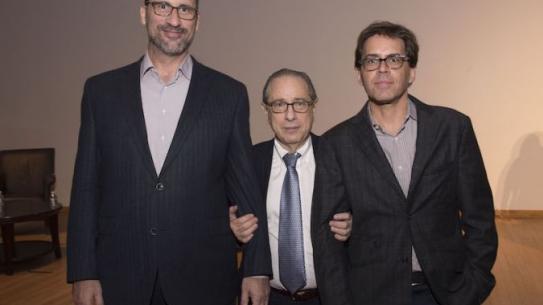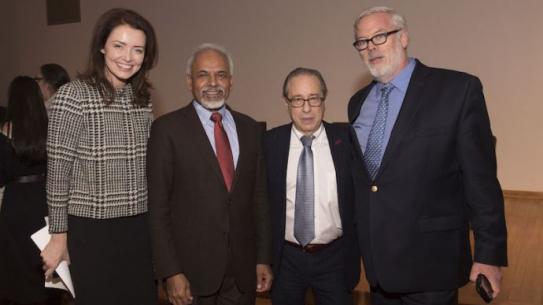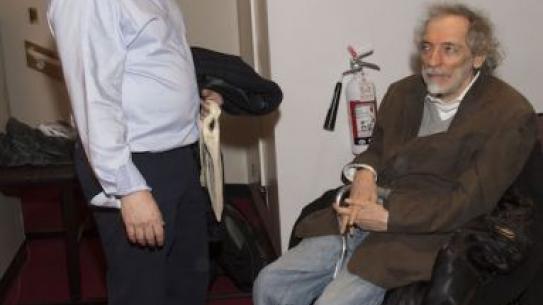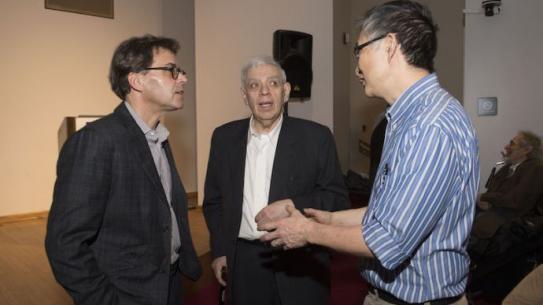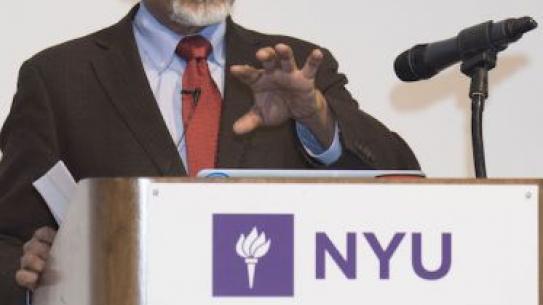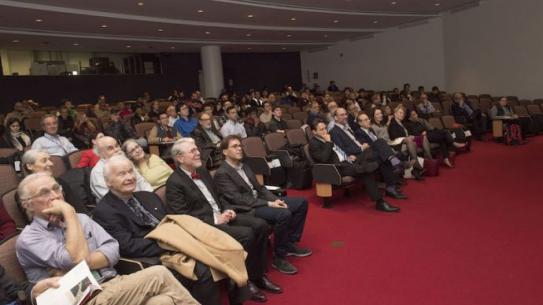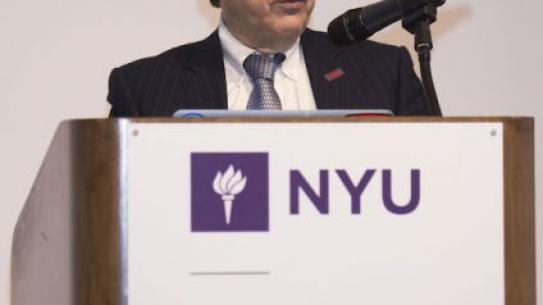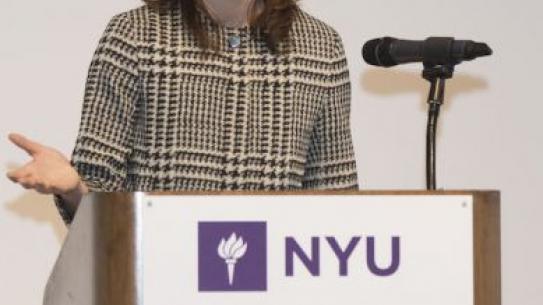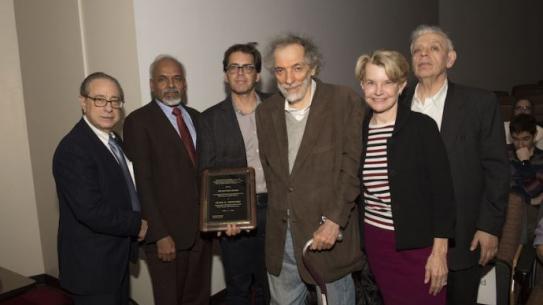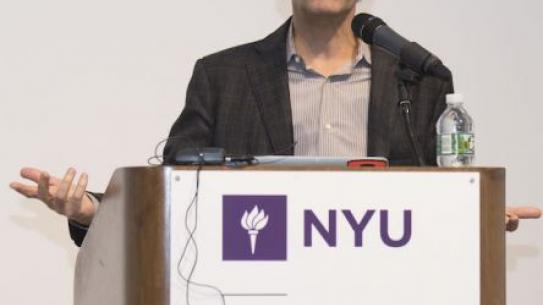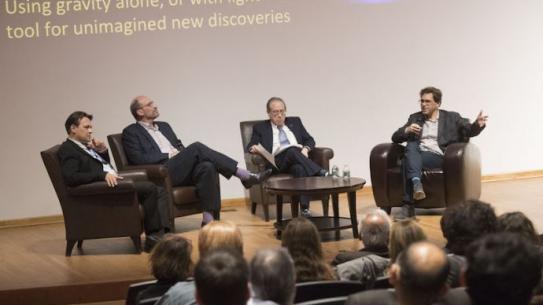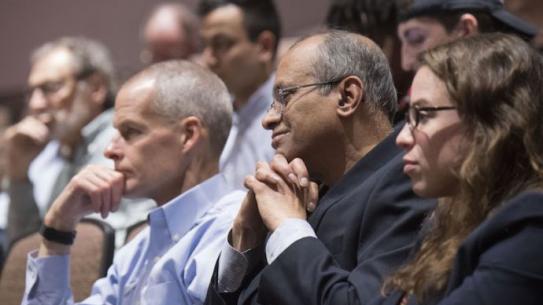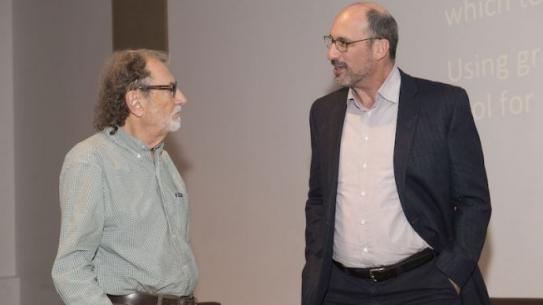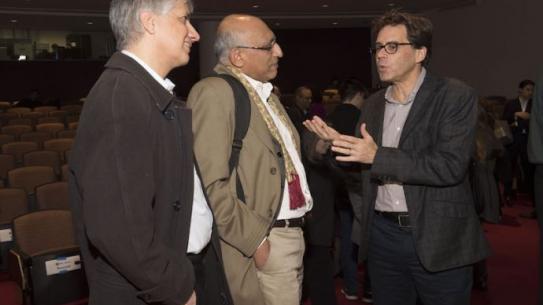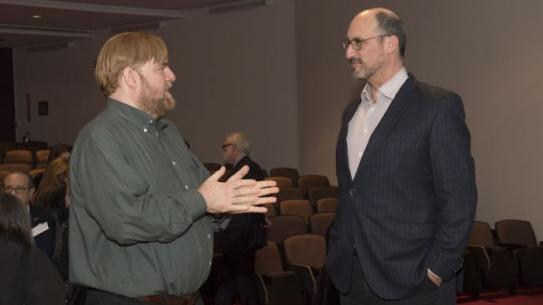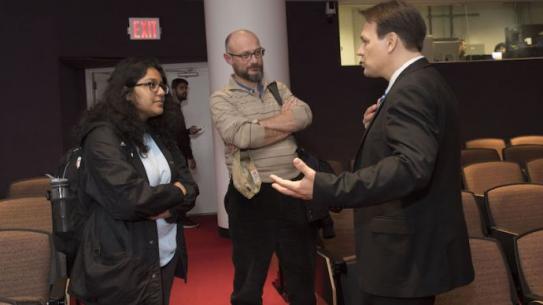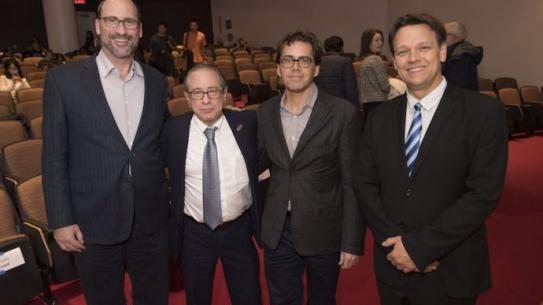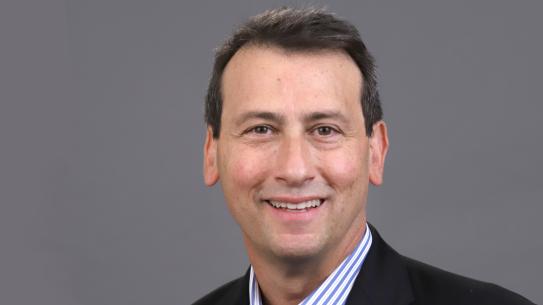LIGO Scientist Details History of Gravitational Wave Detection
2017 Lynford Lecture
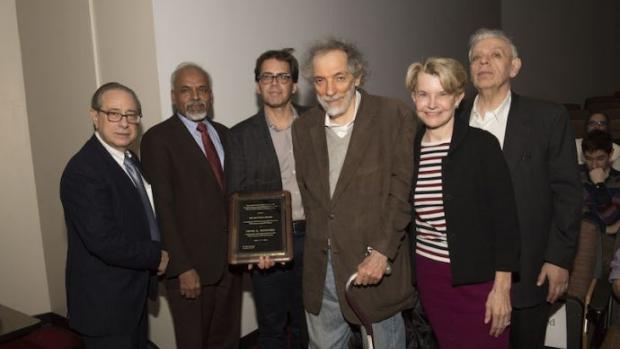
The 2017 Lynford Lecture highlighted the landmark 2015 detection of gravitational waves by LIGO. From left: Jeffrey Lynford; Dean Katepalli Sreenivasan; Dr. Peter Fritschel, the 2017 Lynford lecturer; Gregory Chudnovsky; Tondra Lynford; and David Chudnovsky.
On September 14, 2015, the Laser Interferometer Gravitational-wave Observatory (LIGO) run by the Massachusetts Institute of Technology (M.I.T.) and California Institute of Technology (CalTech) made its landmark discovery — the direct detection of gravitational waves. These waves emanate from cataclysmic events, such as two black holes or two neutron stars merging, which distort space-time and cause ‘ripples’ that travel out across the universe. Gravitational waves have long been on the minds of physicists since Albert Einstein’s 1916 theory of general relativity, which claimed their existence but asserted they would remain undetectable.
Lynford Lecture
At the 2017 Lynford Lecture, Dr. Peter Fritschel, a senior research scientist at the M.I.T. LIGO Laboratory and Kavli Institute, detailed the exciting story behind LIGO's historic detection of gravitational waves. Though Albert Einstein predicted the existence of gravitational waves in his 1926 general theory of relativity, it took another 100 years until Fritschel and fellow LIGO colleagues detected a wave that reached the Earth after two black holes merged some 1.3 billion years ago.
After 100 years of research and experimentation, and the development of a laser interferometer capable of measuring the tiniest wrinkle in space-time caused by a passing gravitational wave, LIGO detected a gravitational wave that reached our planet some 1.3 billion light years after a collision of two black holes. In October 2017, the work of three LIGO pioneers — MIT physicist Rainer Weiss and CalTech physicists Kip Thorne and Barry Barish — received the most prestigious of awards, the Nobel Prize in Physics.
“It’s one of the greatest physics and engineering feats ever accomplished by humans. It’s a wonderful testament to human ingenuity and was the accomplishment of almost two successive generations of scientists, in which instant gratification was not the operative philosophy,” Dr. Katepalli R. Sreenivasan explained in his welcoming remarks to the 2017 Lynford Lecture on November 30 that featured Dr. Peter Fritschel, a core member of the team who made the incredible discovery in 2015.
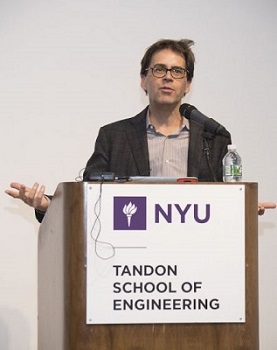
Dr. Peter Fritschel
Dr. Fritschel joined a long line of prestigious speakers — luminaries in their fields — who have spoken at NYU Tandon School of Engineering over the past 18 years at the Lynford Lectures, which are supported by Jeffrey Lynford, the Vice Chairman of the Board for the Port Authority of New York and New Jersey and NYU Tandon board member, his wife Tondra, and Drs. David and Gregory Chudnovsky, co-directors of the school’s Institute for Mathematics and Advanced Supercomputing (IMAS).
Also on hand that evening was Lindsey Boylan, Chief of Staff and Executive Vice President of Governor Andrew Cuomo’s Empire State Development, who shared the governor’s special connection to the Lynford Lectures. At the inaugural event in 1998, Mario Cuomo, former governor of New York, introduced the lecture on string theory. “There’s certainly an unintended symmetry in my being here this evening on behalf of Gov. Andrew Cuomo, 20 years after his father stood in this very room. We’ve come full circle in such a meaningful way,” Boylan expressed.
The Chudnovsky brothers presented Dr. Fritschel with the 2017 IMAS award, highlighting his leadership of “the LIGO team in harnessing the power of LIGO detectors to map the universe.”
A Senior Research Scientist at the M.I.T. LIGO Laboratory and Kavli Institute, Dr. Fritschel has worked with gravitational wave detection for over 25 years, collaborating with Weiss, his colleague, mentor, and LIGO co-founder who spoke at NYU Tandon last year. Recently named a co-recipient of the 2018 Lancelot M. Berkeley Prize for his leadership role in the development of Advanced LIGO detectors, Dr. Fritschel has co-authored multiple articles on the subject, and is a council member of the LIGO Scientific Collaboration (LSC).
The Long-Awaited ‘Chirp’
Jumping across time, from the black hole merger 1.3 billion years ago to the theories of Isaac Newton and Einstein, Dr. Fritschel described the scientific discoveries and theories that spurred the development of the LIGO observatory and its goals of proving physical detection was possible.
With support from the National Science Foundation, Weiss, Thorne and Barish led a team of physicists and engineers to construct the laser interferometer observatories in both Washington State and Louisiana. Describing how the interferometers work, Dr. Fritschel explained that two L-shaped arms — spread out over 4 miles — house suspended mirrors, beam splitters, and a special cavity to repeatedly reflect micron laser beams back and forth until they eventually merge together, creating an interference pattern that allows for measurement of the most miniscule distance changes. Gravitational waves, Dr. Fritschel acknowledged, are incredibly faint and since 2008, LIGO endeavored on extensive enhancements to its detectors, developing Advanced LIGO (of which Dr. Fritschel helped lead). With its greater sensitivity, the detectors simultaneously measured the 2015 wave, or ‘chirp’ heard around the world, demonstrating the brief but monumental moment the wave passed through the Earth.
Dr. Fritschel described LIGO’s continued detection of gravitational waves, including this past August’s detection of waves from merging neutron stars. Much of the future of gravitational wave detection and mapping of the universe rests on the collaborative efforts of detectors across the world (and even one that will be in space), he explained.
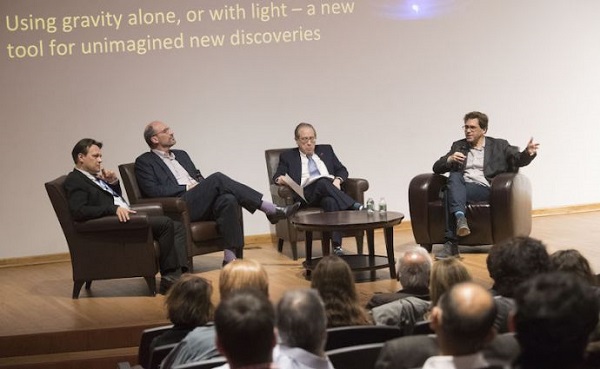
The evening's panel featured Szabolcs Marka, Andrew MacFayden, moderator Jeffrey Lynford, and Dr. Peter Fritschel.
Moderating the evening’s panel, Lynford led a unique conversation between Fritschel, Andrew MacFayden, NYU Associate Professor of Physics and the Center for Cosmology and Particle Physics, and Szabolcs Marka, Walter O. LeCroy Jr. Professor Physics at Columbia, on the far-reaching impact of LIGO’s work, the next generation of wave detection and discoveries about neutron stars, and advice for the future physicists and engineers — the students at universities like NYU Tandon.
Fritschel offered some words of wisdom: “If you find yourself working on a problem you find interesting and challenging, and you’re working with a great team, that’s what will keep you going, even if you don’t know where it will lead.”
Camila Ryder
Graduate School of Arts and Science
Master of Arts in English Literature, Class of 2018


